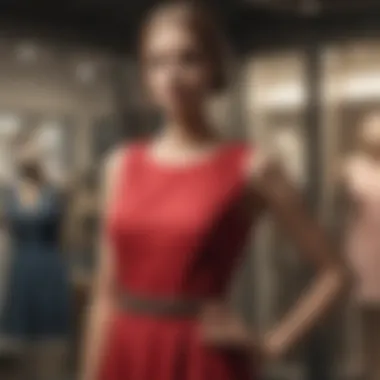Explore the Top Dress Stores for Every Style


Intro
The fashion industry is a dynamic and ever-evolving sphere, with dress stores playing a significant role in shaping trends and consumer preferences. Each season brings a new wave of styles, colors, and fabrics that cater to the diverse tastes of women across various demographics. Understanding the landscape of popular dress stores becomes essential for anyone looking to keep their wardrobe fresh and trendy.
Within this article, we take an in-depth look at the prominent dress retailers that have carved their niches. By analyzing what sets them apart, we aim to provide a comprehensive guide to the current dress store market. This exploration will also delve into the evolving fashion trends and how they influence what consumers seek in their shopping experiences.
Fashion Trends
The world of fashion trends is often dictated by the seasons, and the current landscape offers a rich tapestry of exciting styles. From flowing summer dresses to cozy winter ensembles, understanding seasonal styles is crucial for any fashion enthusiast.
Seasonal Styles
Each season brings with it specific colors, fabrics, and cuts that are prevalent in dress design. For instance, pastel hues and floral patterns are typically associated with spring, while earthy tones might dominate the fall collections. Retailers like Zara and Forever 21 closely follow these seasonal changes, ensuring their inventories reflect the latest trends.
When shopping, consider these style elements:
- Fabric: Lightweight cottons and linens for summer; heavier knits and wools for winter.
- Color palettes: Bright colors for warmer months; deeper shades in cooler weather.
- Length and cut: Mini and midi dresses are popular in the summer, while maxi silhouettes often return during the fall.
Influencer Inspirations
The influence of social media cannot be understated in today's fashion market. Influencers shape consumer preferences by showcasing their styles through platforms like Instagram and TikTok. Often, their endorsements can propel certain dress stores into the limelight. Many followers seek to emulate their favorites by purchasing identical or similar outfits.
Popular influencers frequently collaborate with dress retailers, creating exclusive collections that resonate with their audience. This trend points to a key intersection between digital marketing and fashion retail, making it essential for stores to engage in influencer partnerships.
"The interplay between social media and dress retail is not just marketing; it's a reflection of cultural shifts in consumer behavior and brand engagement."
The The End
An exploration of popular dress stores reveals a rich interplay of fashion trends, consumer desires, and market adaptability. As women continuously seek styles that resonate with their personal identity, the importance of understanding these dynamics in dress retail becomes apparent. This guide serves as a resource for readers to navigate the complexities of dress shopping, ensuring informed choices in a diverse market.
Prelims to Popular Dress Stores
The world of fashion retail is a dynamic and multifaceted landscape, and understanding the role of popular dress stores is essential. These establishments serve as more than just outlets for clothing; they are cultural hubs that reflect consumer desires, trends, and values. This section seeks to illuminate why analyzing popular dress stores is crucial for both consumers and industry stakeholders.
Importance of Popular Dress Stores
Popular dress stores are often the first point of contact for many consumers in their fashion journey. They provide a wide range of styles, catering to various demographics, preferences, and occasions. This accessibility makes them vital in shaping fashion trends and consumer behavior. Moreover, these stores often become trendsetters, influencing what styles are considered fashionable and desirable.
Understanding the Market: Analyzing the offerings and strategies of popular dress stores helps to understand market dynamics. This includes consumer preferences, emerging trends, and the factors that facilitate success in a competitive retail environment.
Benefits of Studying Retail Trends
- Consumer Insights: Knowing which stores are popular allows brands to tailor their marketing strategies. Insights into consumer preferences can guide product development and inventory management.
- Fashion Trends: By examining successful dress stores, one can identify the latest fashion trends and how they evolve over time. This knowledge benefits both customers and retailers aiming to keep their offerings relevant.
- Retail Strategies: Learning what makes certain stores thrive can inform business practices for emerging and established retailers alike. Understanding customer engagement and store layout can improve overall shopping experiences.
Considerations About Dress Stores
While many dress stores claim popularity, not all are equivalent in quality or service. Factors such as brand reputation, customer service, and ethical practices contribute to the long-term success of a dress store. Sustainability is an increasing concern among shoppers, making it important for stores to align their practices with consumer values.
In summary, the exploration of popular dress stores provides valuable insight into the fashion industry. It highlights essential elements like consumer behavior, retail strategies, and emerging trends. As we continue through this article, we will delve deeper into these aspects to uncover the factors that contribute to the standing of these influential retailers in the market.
Defining Popularity in Fashion Retail
In the realm of fashion retail, popularity serves as a crucial metric that influences consumer behavior and impacts the operational success of dress stores. This section provides an in-depth look at what defines popularity in this industry, emphasizing the factors that contribute to a store’s reputation. Understanding this concept is vital, as it affects how retailers position themselves in a competitive market, shaping their brand identity and marketing strategies.
Popularity can be seen as a reflection of a store's ability to resonate with its target audience. Retailers who are able to connect with customers not only on a superficial level but also through shared values and style preferences tend to achieve greater visibility and desirability in the fashion landscape. This connection not only enhances customer loyalty but also translates into increased sales and overall brand strength.
Consumer Preferences and Buying Behavior
Consumer preferences play a critical role in shaping the popularity of dress stores. These preferences are influenced by a variety of factors including trends, seasonality, and personal style. When consumers make purchases, they often seek retail experiences that align closely with their individual identities and needs.
Some key factors include:
- Changing Fashion Trends: As styles evolve, consumers gravitate toward stores that reflect the latest trends. Familiarity with current styles helps dress stores adapt quickly and maintain relevance.
- Brand Image: A store's image significantly impacts consumer choices. A brand that projects a modern, ethical, or luxurious image may attract a specific demographic seeking those qualities.
- Social Influence: The power of influencers and social media cannot be overstated. Recommendations from friends or admired figures can lead to increased traffic and sales for popular stores.


Consumer buying behavior is a constantly shifting target, reflecting broader societal trends and individual motivations.
Factors Influencing Retail Success
Several factors contribute to the success of popular dress stores in the retail market. These factors often intersect, creating a holistic ecosystem that supports sustained growth and relevance. Understanding them helps to illustrate why some stores flourish while others may struggle.
- Product Quality: Quality is non-negotiable in retail. Consumers expect durable and well-made products. Stores that consistently deliver high-quality dresses are likely to stand out.
- Customer Service: Exceptional customer service can differentiate a store from its competitors. Shoppers value personalized experiences, fast service, and hassle-free returns.
- Store Atmosphere: The physical environment of a store can significantly impact a shopping experience. Well-designed spaces invite customers to linger longer and explore more.
- Pricing Strategy: Competitive pricing can often determine a store's accessibility. Stores that offer value for money tend to attract a broader customer base, promoting popularity.
- Effective Marketing: Strategic marketing efforts, including promotions and collaborations, can elevate a store’s visibility. Innovative campaigns that resonate with the target audience foster engagement and encourage foot traffic.
"Understanding consumer behavior and the dynamics of retail popularity is essential for any dress store aiming for long-term success."
In summary, defining popularity in fashion retail encapsulates a complex interplay of consumer preferences and the overarching factors that contribute to a store's success. By emphasizing these elements, retailers can ensure they meet the evolving expectations of their customers.
Emerging Trends in Women's Fashion Retail
Emerging trends in women's fashion retail are shaping the industry in profound ways. Understanding these movements is essential not only for retailers but also for consumers who want to stay ahead of the fashion curve. This section focuses on two key components of the current landscape: sustainable fashion movements and the influence of social media. By examining these aspects, readers can better understand the evolving nature of dress stores and how their offerings align with contemporary values and lifestyles.
Sustainable Fashion Movements
Sustainable fashion is not just a trend; it reflects a fundamental shift in how the fashion industry operates. This movement emphasizes ethical practices, environmental stewardship, and social responsibility. Today’s consumers increasingly prioritize fashion brands that align with their values, specifically regarding production processes and material sources.
The rise of brands like Reformation and Everlane exemplifies this shift. They utilize sustainable materials, promote fair labor practices, and engage in transparency about their production processes. As consumers look for ways to make responsible choices, sustainability will remain a critical factor in determining popular dress stores.
Moreover, this movement has also encouraged the second-hand market. Stores like Depop and Poshmark attract a young demographic that values unique, vintage pieces while promoting a circular economy.
Here are some important points regarding sustainable fashion:
- Reduced Waste: Brands are finding innovative ways to minimize waste, such as using fabric scraps in new designs.
- Eco-Friendly Materials: Many retailers have begun using organic cotton, recycled polyester, and other sustainable materials in their collections.
- Local Production: Sourcing and manufacturing locally can reduce carbon footprints and support local economies.
The Influence of Social Media
Social media plays a pivotal role in connecting consumers with fashion trends and dress stores. Platforms like Instagram and TikTok have transformed how brands market their products and how consumers discover new styles. Influencers and fashion icons often dictate trends, significantly impacting retail strategies.
Retailers are now adapting to this landscape by collaborating with influencers who resonate with their target audience. This strategy not only increases visibility but also builds authenticity and trust in the eyes of consumers. For example, when a popular influencer showcases a dress from a specific store, it can lead to an immediate surge in interest and sales for that item.
Furthermore, social media enables customers to share their styling choices and reviews, creating an interactive community around fashion. This engagement fosters a sense of belonging among consumers, influencing their purchasing decisions.
Consider these factors:
- Real-Time Trends: Social media allows immediate sharing of new trends, quickly shifting consumer preferences.
- User-Generated Content: Feedback and content created by users can enhance credibility for dress stores.
- Global Reach: Smaller brands can gain international attention through effective social media strategies.
"Sustainable fashion and social media are defining the future of retail, creating a more connected and conscientious consumer base."
Top Dress Stores to Consider
In the exploration of fashion, understanding the significance of dress stores is crucial. Dress stores offer more than just garments; they provide a curated experience that meets the diverse needs of their clientele. The selection might include anything from casual wear to formal attire, ensuring that every customer finds something suitable. Popular dress stores have a unique ability to define trends, drive sales, and shape the consumer market. Adapting to consumer behaviors serves as a key element in differentiating successful retailers from those that struggle. Therefore, diving into the profiles of notable dress stores not only helps consumers make informed shopping decisions but also highlights the broader retail environment.
Store Profiles and Offerings
Examining specific store profiles reveals the assortment each retailer offers. For example, Zara is renowned for its fast-fashion model and trendy styles, appealing to young adults and fashion-forward individuals. The merchandise frequently rotates, ensuring that customers have access to the latest trends. On the other hand, stores like Anthropologie cultivate a bohemian aesthetic, catering to consumers looking for unique and artistic dresses.
Diverse offerings extend beyond physical clothing items. Many retailers now provide online insight such as fashion guides, recommendations based on personal style, and easy return policies. Target, for instance, offers an impressive balance of affordability and variety, making it accessible to a wide audience.
Some dress stores place a strong emphasis on local designers or sustainable practices, like Reformation, which has garnered attention for its eco-friendly efforts. Consumers are increasingly interested in where products come from, and these retailers respond by showcasing ethical considerations in their selections.
Price Points and Accessible Fashion
The range of price points in dress stores largely determines accessibility. H&M and Forever 21 exemplify brands that provide trendy clothing at lower prices. This model attracts a broad customer base, particularly younger shoppers who seek fashionable items without a significant financial commitment.
On the other hand, brands like Nordstrom offer a more premium selection, focusing on quality items that often come with a higher price tag. Nevertheless, they frequently feature a variety of products at different price points, which caters to a larger audience.
While some consumers prefer high-end department stores, others gravitate towards budget-friendly options. The understanding of various price barriers is essential for retailers in order to create attractive pricing strategies.
Providing deals, sales, and exclusive discounts can greatly enhance a store's appeal. Some retailers may choose to focus on membership or loyalty programs to ensure repeat business while providing value to their customers.
"The balance between quality and affordability often dictates the consumer's purchasing decision."
These aspects emphasize the importance of price point in establishing a successful dress store presence in a competitive market. Overall, the integration of customer preferences, store profiles, and pricing strategies culminates in a dynamic shopping experience that appeals to women of all ages.
In-Store Shopping vs. Online Shopping


The comparison between in-store shopping and online shopping is significant in today's fashion retail landscape. This discussion highlights essential elements that influence consumer decisions and outlines the respective benefits of each method. Understanding the varying preferences and needs of shoppers can help brands more effectively cater to their target audiences.
Benefits of In-Store Experiences
Shopping in physical stores remains a cherished experience for many consumers. Here are several advantages:
- Tangible Interaction: Shoppers can feel fabrics, assess the fit, and try dresses on. This tactile engagement often leads to better purchase satisfaction.
- Personal Service: Many consumers prefer face-to-face interaction with staff who can provide recommendations tailored to individual styles and body shapes. Human connection can enhance the shopping experience.
- Immediate Gratification: With in-store shopping, customers can take their purchases home right away. There is no waiting for deliveries, which can sometimes be lengthy.
- Social Experience: Shopping can be a communal activity. Many enjoy shopping with friends or family, making it a social outing rather than a chore.
In-store shopping creates an opportunity for consumers to engage fully with products, leading to informed choices.
Despite the increase in online shopping popularity, physical stores hold important qualities that cater to shoppers looking for a personal touch.
Conveniences of Online Retail
On the other hand, online shopping has its own set of conveniences that attract a growing number of consumers:
- Accessibility: Shoppers can browse from anywhere, at any time. This flexibility allows busy individuals to shop around their schedules.
- Broader Selection: Online platforms often provide a wider array of designs, sizes, and styles. This vast selection can enhance the chance of finding the perfect dress.
- Price Comparisons: Online shopping enables easy price comparisons. Consumers can quickly find the best deals, leading to informed financial decisions.
- Home Delivery: The convenience of doorstep delivery cannot be overstated. Shoppers can have items delivered directly to their homes without the need to transport them.
Customer Experience and Engagement Strategies
The realm of dress stores has shifted significantly in recent years. This evolution places a strong emphasis on crafting superior customer experiences. Techniques aimed at enhancing customer engagement are vital not only for attracting new shoppers but also for retaining loyal clientele. As shoppers become more discerning, their expectations rise. They seek meaningful interactions that resonate beyond mere transactions.
Retailers now prioritize creating positive, memorable experiences by focusing on customer service, personalized shopping, and tailored services. A positive experience leads to customers promoting the store through word-of-mouth, which is essential in today's market. Companies investing in strong customer engagement strategies often observe beneficial impacts such as increased sales, a loyal shopper base, and enhanced brand reputation.
Building Loyalty through Customer Service
Customer service serves as a cornerstone for cultivating brand loyalty. In the competitive landscape of dress retail, providing exceptional service can distinguish a store from its competitors. Each customer interaction is an opportunity to build a lasting relationship.
Empathy and understanding are critical attributes in customer service. When customers feel valued, they are more likely to return. Here are some key approaches to effective customer service:
- Personalized Attention: Taking the time to understand individual preferences creates a sense of belonging. Assisting clients in a manner that aligns with their personal style can foster emotional connections.
- Knowledgeable Staff: Trained employees who are well-versed in the latest trends and product offerings can help guide choices. Their expertise can earn trust, making customers more inclined to seek guidance.
- Feedback Incorporation: Actively seeking customers' opinions and showing that their suggestions are valued not only makes customers feel heard but also enhances the brand’s offerings.
As women’s fashion constantly evolves, maintaining a commitment to high standards of customer service allows stores to stay relevant and engaging.
Utilizing Feedback for Improvement
Analyzing customer feedback is crucial for continuous improvement. Retailers who actively adopt customer critiques can better adapt to changing preferences. This feedback loop helps in identifying areas needing enhancement.
A few strategies to effectively utilize feedback include:
- Surveys and Questionnaires: Regularly sending surveys can help gather essential opinions on product selection, store layout, and overall shopping satisfaction.
- Online Reviews and Comments: Monitoring digital platforms like social media and review websites provides insights. Encouraging customers to share their experiences opens up avenues for growth and correction.
- Focus Groups: Engaging a small group of customers to discuss experiences can yield in-depth insights. This method can uncover specific pain points that need addressing.
"Utilizing feedback effectively can turn a simple shopping trip into a memorable experience, leading to increased customer satisfaction and loyalty."
Fashion Icons and Their Impact on Dress Stores
Fashion icons play a significant role in shaping the landscape of dress retail. Their influence extends beyond mere aesthetics; it encapsulates trends, consumer engagement, and branding strategies of dress stores. Understanding this impact is crucial for recognizing how fashion evolves and how stores adapt to maintain relevance in a rapidly changing market.
The presence of a fashion icon can elevate a dress store's profile, making it a go-to destination for style-conscious consumers. When a prominent figure endorses a brand or collaborates on a collection, the store often sees an increase in foot traffic and online engagement.
Moreover, the collaboration can lead to a shift in consumer perception about a brand. If a well-regarded celebrity promotes a specific dress store, it instills a sense of quality and desirability. This is especially true in an era where authenticity is valued; consumers are increasingly drawn to brands that align with their values.
Celebrity Collaborations and Trends
Celebrity collaborations have become a strategy that dress stores leverage to capture consumer interest. These partnerships often result in limited-edition collections that use the celebrity's unique style and aesthetic. For instance, when Selena Gomez collaborated with Puma, the collection displayed a blend of her personal style with the brand’s core offerings, resulting in a striking appeal to her fan base.
Such collaborations not only attract existing fans but also introduce new customers to the brand. This cross-pollination of audiences enables dress stores to reach diverse demographics, tapping into varying fashion tastes. Furthermore, the exclusivity associated with limited release collections creates a sense of urgency, encouraging consumers to make purchases swiftly.
The trends stemming from these collaborations often set the tone for mainstream fashion. When dress stores align with notable figures, they tend to adopt styles that resonate with current cultural sentiments, thus driving broader trends across the industry.
Street Style Influences
Street style has emerged as a prominent force in contemporary fashion. Unlike the traditional notions of high fashion, street style embodies the organic fusion of diverse sartorial expressions. Influenced by the dynamic nature of urban life, it has the power to redefine how dress stores approach their collections.
Dress stores that embrace street style often feature pieces that reflect a blend of comfort, individuality, and versatility. This has resulted in a new direction where styles are more accessible and less about high-end exclusivity. The rise of platforms like Instagram has allowed street style influencers to showcase their outfits and inspire sartorial choices quickly, leading to rapid dissemination of trends.


"Street style is no longer just about what happens on the runway; it’s where real-life influences meet fashion."
Retailers must pay attention to street style to stay relevant and appeal to younger generations, who prioritize authenticity in their shopping choices. By adopting elements from street fashion—like oversized silhouettes or mix-and-match ensembles—dress stores can resonate more with modern consumers.
Overall, the interplay between fashion icons, celebrity collaborations, and street style influences constitutes a robust dynamic that continuously shapes dress retail. For dress stores, understanding these aspects is essential for navigating an intricate and ever-evolving landscape. By tapping into these influences, stores not only remain trendy but also foster a strong connection with their clientele.
Global Perspectives on Dress Stores
The realm of dress retail is not confined to a single demographic or locale. Understanding Global Perspectives on Dress Stores sheds light on the nuances that define fashion consumption worldwide. This section emphasizes the significance of different markets, cultural influences, and regional characteristics that contribute to the success and evolving nature of dress stores globally. By exploring these perspectives, we can appreciate how local trends fuse with global standards to shape consumers’ choices.
Regional Variations in Dress Retail
Dress retail varies tremendously across regions, influenced by local customs, climate, and socio-economic factors. For instance, in Europe, fashion is often characterized by its chic and trend-forward styles, while Asian markets might emphasize vibrant colors and intricate patterns. American consumers, on the other hand, may gravitate towards casual wear and practicality, reflecting a lifestyle that favors comfort alongside style.
Key variations include:
- Climate Sensitivity: Warm climates feature lighter fabrics and more casual styles, making sundresses highly popular in such regions.
- Cultural Heritage: Stores in regions with strong cultural identities often incorporate traditional elements into modern designs. This results in unique collections that celebrate local craftsmanship.
- Economic Factors: Affordability plays an essential role. Areas with higher disposable income might see a rise in luxury brands while budget-friendly stores thrive in more cost-conscious markets.
These variations are crucial for retailers to understand. Tailoring their offerings to resonate with regional preferences heightens brand relevance.
Cultural Influences on Fashion Choices
Cultural background profoundly shapes fashion choices. Each culture brings its own set of values and aesthetics which influence what is deemed fashionable. For example, in many Middle Eastern countries, modesty is a key component of apparel. This has driven many dress retailers to feature collections that meet these cultural requirements while still promoting stylish options. Conversely, Western fashion trends may lean toward individualism and self-expression, allowing for more diverse styles in dress options.
Some significant cultural influences include:
- Traditions and Values: Dress stores may align their offerings with significant cultural traditions. Understanding these can enhance customer relatability.
- Fashion Icons: Local fashion icons can greatly influence consumer preferences, often setting trends that resonate within specific cultures.
- Globalization: With the rise of e-commerce, cultural diffusion is prevalent. Consumers have access to global trends, allowing them to incorporate them into their local contexts.
Cultural understanding is key to success in the global marketplace. Dress stores that navigate and respect these cultural dynamics often find themselves at a competitive advantage.
By recognizing the intricate interplay of regional characteristics and cultural influences, dress retailers can better position themselves in the international landscape. This not only fosters inclusivity but also develops a deeper connection with a wide array of consumers.
Future of Dress Retail
The future of dress retail is a topic of significant relevance as it not only shapes the shopping habits of consumers but also defines the trajectory of fashion businesses in an ever-evolving landscape. With advancements in technology, shifting consumer expectations, and the rise of new shopping paradigms, understanding these aspects is crucial. Retailers must adapt to maintain relevance and continue to meet customer needs effectively. This section explores two major elements that will shape the dress retail industry: the integration of technology in shopping experiences, and preparing for the next-generation consumers.
Technology Integration in Shopping
As we look ahead, the integration of technology plays a pivotal role in how dress retail operates. Many retailers are already leveraging technology to enhance consumer experiences. Notable advancements include augmented reality applications that allow customers to virtually try on dresses. This innovative tech solution can significantly reduce return rates and increase customer satisfaction. Moreover, advanced data analytics enables stores to better understand inventory management, allowing them to stock popular items and personalize recommendations for each shopper.
Some examples include:
- Mobile Apps: Many stores offer dedicated apps that provide a seamless shopping experience, making it easier for customers to browse collections, reserve items, and track orders.
- Contactless Payments: With the increase in digital wallets and mobile payment systems, retailers are now able to provide quick and convenient payment methods that cater to a growing demand for efficiency.
- Social Commerce: Platforms such as Instagram and Facebook are transforming how women shop, with integrated shopping functionalities that allow for direct purchases from social media.
Technology integration is more than just an upgrade; it represents a shift in how consumers interact with brands. As retailers embrace these innovations, they bridge the gap between online and physical shopping, creating a more unified experience.
Preparing for Next-Generation Consumers
The landscape of consumer behavior is continually changing, and retailers must prepare for the next generation of shoppers. Today's youth, commonly referred to as Gen Z, have unique values and preferences that heavily influence their buying decisions.
Key considerations include:
- Sustainability: This demographic is highly concerned about environmental issues. Retailers that promote sustainable practices, such as using eco-friendly materials and ethical labor practices, will likely attract this consumer base.
- Authenticity: Younger shoppers favor brands that are genuine and transparent. They seek connections with brands that reflect their values and aspirations.
- Engagement through Technology: The next generation has grown up with technology, and they expect brands to be innovative. Engaging them through interactive online experiences, such as personalized shopping or gamified apps, will be essential for retention and loyalty.
"Understanding the values and behaviors of next-generation consumers is essential for dress retailers to thrive in a competitive market."
The future of dress retail requires not only a clear grasp of current trends but also an anticipatory approach to forthcoming shifts. By integrating technology and adjusting strategies for new consumer values, retailers position themselves to succeed in an ever-changing market.
The End: The State of Dress Stores
In examining the dynamics of popular dress stores, it becomes clear that these retail establishments are more than mere shopping destinations. They serve as cultural hubs that reflect the preferences and values of their customers. The significance of this topic lies in understanding how these stores adapt to the ever-changing landscape of fashion and consumer expectations.
One of the fundamental elements discussed in this article is the shifting consumer preferences and buying behaviors that shape the retail environment. With the rise of sustainability and ethical fashion, many stores are adjusting their offerings to resonate with conscious consumers. This responsiveness not only strengthens customer loyalty but also helps in building a brand identity that aligns with contemporary values.
Moreover, the exploration of digital advancements showcases how technology is woven into the fabric of shopping. Stores that embrace technology tend to perform better. They provide customers with tools for a seamless shopping experience, whether online or in-store. The integration of features such as virtual fitting rooms and mobile apps enhances engagement. Furthermore, data analytics play a crucial role in tailoring the inventory to match consumer needs, ensuring that the selection remains relevant and desirable.
Additionally, the focus on customer experience is pivotal. Retailers implementing effective engagement strategies are more likely to foster long-term relationships with their customers. Positive experiences, such as knowledgeable staff and easy return policies, can significantly impact consumer satisfaction.
"The future of dress stores lies in their ability to adapt and understand the multifaceted nature of consumer demands."
Understanding these multifactorial elements allows for a comprehensive view of the state of dress stores today. The way ahead will likely be informed by ongoing shifts in consumer behavior, technological advancements, and a commitment to meeting evolving standards of quality and sustainability.



